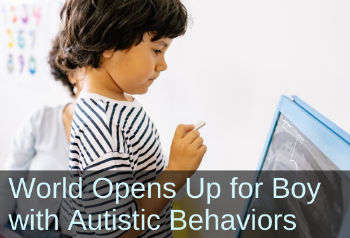Submitted by Erika Ellis, OTD, OTR/L

| Before | After |
|---|---|
| Had no interests other than trains | Has begun exploring new activities and playing with his brother |
| Did not enjoy books | Has started to enjoy looking at books, and can now hold a book with one hand while turning the page with the other, which he was unable to do before |
| Would not try to articulate words | Now attempting to articulate words |
| Would not try new foods | Had started to explore new foods |
| Refused to write or participate in any fine motor activity | Began to be able to sit at a table and scribble on paper with minimal prompting, and eventually learn to draw a circle |
This case study is based on my work with a 4-year-old boy who I am going to call Ivan (not his actual name). Ivan was referred to OT for developmental delays and was being evaluated for autism and various genetic conditions. He was intelligent and depended on order/organization for success. He was also obsessed with trains and only trains. He could tell you every detail related to trains and even the companies that made them, but that was where his interest stopped. After about a month of collaborating with him I could still not identify anything that would strike his interest enough to motivate him to participate besides using trains as positive reinforcements. Then, I started this [Brain and Sensory Foundations] courseand was learning about ATNR [Asymmetrical Tonic Neck Reflex] at a deeper level. I formally and informally checked and stimulated his ATNR reflex to find both sides significantly active [unintegrated]. I demonstrated the reflex to his mother, and she was almost in shock to how prevalent the movement resembled the picture in the book. This identification opened a whole new door for our therapy.
I immediately started implementing the suggested playful developmental movement activities for ATNR integration [from the Brain and Sensory Foundations course] and within two weeks Ivan’s mom came back and said that he started to enjoy looking at books and was now able to hold the book with one hand while turning the page with the other (which he was unable to do before due to active ATNR).
On week three, his mom reported that he has become fascinated with numbers and would focus on them with deep intent, which we started to incorporate into number led obstacle courses that he now loved. This also increased our ability to introduce rhythmic movement #1 and could also incorporate therapeutic play for overall strengthening.
After 2 months of Ivan refusing any type of handwriting/Fine Motor activity, he started drawing vertical lines during the fourth week after initiating ATNR integration strategies. By week five he was able to hold the paper with one hand and initiate drawing a circle.
After identifying the active ATNR reflex and initiating integration techniques, Ivan began to flourish in his therapy. His mother noticed that he began exploring new activities and playing with his brother in ways that he never had before. He was willing to sit at the table and scribble on paper with minimal prompting. Following the introduction of ATNR and following the vast improvements observed within the clinic and within the home environment, I introduced the Babkin hand reflex [from the Brain and Sensory Foundations course] after Ivan’s mother revealed excessive drooling in addition to Ivan completing a speech pathology evaluation.
At first, he demonstrated poor tolerance, but then his speech therapist, mother, and myself observed him attempting to articulate words (which he did not do prior) after just 2 weeks with performing 2x/day. In addition, he started to explore foods that he had not previously explored. And Ivan's mom noticed improvement with less drooling!
Overall, his progress started to thrive once identifying his areas of need for reflex integration. This is a new area of practice in my profession (besides a single lecture during occupational therapy school) and I now realize the importance and value it holds. We must meet the fundamental and primitive needs of our clients and ourselves to meet the subsequent skill areas. These tools are invaluable, and I cannot wait to continue to use them!
[Edited for length and clarity; emphasis added]

